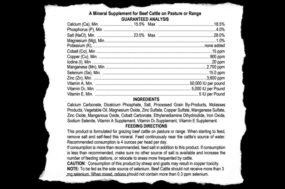U.S. Ag Secretary Tom Vilsack and Dr. John Clifford, the chief veterinary officer at USDA, announced the new rule on Dec. 20, and it was published into the federal register the first week of January.
Key elements to the plan involve cattle livestock identification and movement. Cattle moving interstate must be identified and be accompanied by the proper movement documents, Clifford said.
“If the animal moves interstate, it must be identified and accompanied by the appropriate movement documentation,” said Clifford.
“Beef cattle under 18 months of age, unless they are moved interstate for shows, exhibitions, rodeos or recreations events, are exempt from the official identification requirement in this rule,” Clifford said.”
Click here or scroll down to see a video from USDA Chief Veterinary Officer John Clifford on the specifics of the new traceability rules.
The USDA also grants flexibility to states to use their existing systems for allowable forms of identification, so long as it is an agreed form by the shipping state and receiving state.
“Regulations provide options for the producer to choose the type of identification device that works best for your operations,” Clifford said. He added that movement records must be kept for a period of two to five years, depending on the livestock species.
Equine owners will also be required to identify animals or use travel documents, although some exemptions are in place.
Rule does not require specific ID tag or tell producers what format to use for record keeping. New rule takes effect on March 11, 2013.
“With the final rule announced today, the United States now has a flexible, effective animal disease traceability system for livestock moving interstate, without undue burdens for ranchers and U.S. livestock businesses,” said Vilsack.
“The final rule meets the diverse needs of the countryside where states and tribes can develop systems for tracking animals that work best for them and their producers, while addressing gaps in our overall disease response efforts. Over the past several years, USDA has listened carefully to America's farmers and ranchers, working collaboratively to establish a system of tools and safeguards that will help us target when and where animal diseases occur, and help us respond quickly.”
The government retooled its traceability efforts in 2010 after ditching the National Animal Identification System (NAIS), which was panned by producer groups on a widespread basis.
A new rule in August 2011 raised additional concerns among producer groups when USDA stepped away from approving branding as a nationally recognized ID form.
In the final rule, brands are accepted, along with tattoos and brand registration, as official ID “when accepted by the shipping and receiving states or tribes,” the USDA said.
Other key details included:
* Permanently maintaining the use of backtags as an alternative to official eartags for cattle and bison moved directly to slaughter.
* Accepting movement documentation other than an Interstate Certificate of Veterinary Inspection (ICVI) for all ages and classes of cattle when accepted by the shipping and receiving states or tribes.
* Clarifying that all livestock moved interstate to a custom slaughter facility are exempt from the regulations.
In a statement given Dec. 20, the National Cattlemen’s Beef Association said it was encouraged by the USDA’s comments on the rule and the consideration given to cattle producers.
“Cattlemen and women are looking for a rule that does not come with additional costs and does not hinder the speed of commerce,” said NCBA Chief Veterinarian Kathy Simmons. “Brands will be recognized when accompanied by an official brand inspection certificate as means of official identification for cattle. The rule will also allow flexibility in tagging procedures and paperwork. Most important to cattle producers is the Secretary’s announcement of separate rulemaking for beef cattle under 18 months of age.
“Raising healthy cattle is a top priority for cattlemen. NCBA remains supportive of an animal disease traceability program for cattle health purposes. We commend APHIS for its efforts to listen to concerns of America’s cattlemen in developing this traceability program. NCBA encourages the agency to continue working with industry leaders on this and all animal health issues.”
To learn more about the rule and find fact sheets from USDA on each species’ requirements for identification, go to www.aphis.usda.gov/traceability ![]()
PHOTO
Final rules on traceability issued by the USDA will require all cattle moving across statelines to have an acceptable form of ID from the shipping state and receiving state. Staff photo







